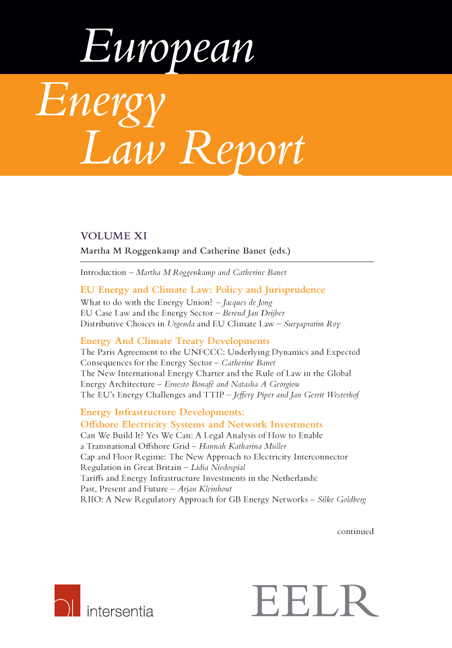Book contents
- Frontmatter
- Editorial
- Contents
- List of Abbreviations
- List of Contributors
- Introduction
- Part I EU Energy and Climate Law: Policy and Jurisprudence
- Part II Energy and Climate Treaty Developments
- Part III Energy Infrastructure Developments: Offshore Electricity Systems and Network Investments
- Part IV Heat Supply Legislation in the Eu
- Part V Security of Energy Supply and Safety
- Chapter XIV Shale Gas and the EU
- Chapter XV Reducing Gas Production from the Groningen Field: The Need to Balance Safe Production with Supply Security
Chapter XIV - Shale Gas and the EU
from Part V - Security of Energy Supply and Safety
Published online by Cambridge University Press: 29 September 2018
- Frontmatter
- Editorial
- Contents
- List of Abbreviations
- List of Contributors
- Introduction
- Part I EU Energy and Climate Law: Policy and Jurisprudence
- Part II Energy and Climate Treaty Developments
- Part III Energy Infrastructure Developments: Offshore Electricity Systems and Network Investments
- Part IV Heat Supply Legislation in the Eu
- Part V Security of Energy Supply and Safety
- Chapter XIV Shale Gas and the EU
- Chapter XV Reducing Gas Production from the Groningen Field: The Need to Balance Safe Production with Supply Security
Summary
INTRODUCTION
After triggering a ‘gas glut’ in the United States, shale gas extraction is currently arriving in Europe. Several oil and gas companies already applied for exploratory licences in a number of European Union (EU) Member States. These applications, however, were frequently met with public resistance. Societal concerns about the environmental sustainability of shale gas extraction were fueled by earth tremors in the United Kingdom and the media coverage of water contamination in America.
It therefore does not come as a surprise that since 2012 several EU bodies, including the European Parliament and the Committee of the Regions, an advisory body representing local and regional authorities in the EU, pressed the European Commission to introduce more stringent regulations on shale gas extraction in the EU. Their demands were underpinned by a couple of scientific reports on shale gas, which arrived at the conclusion that legislative action by the EU was required. By 2014 the Commission responded to that request and put into place a new framework, which is specifically designed to regulate unconventional hydrocarbon extraction.
This chapter proceeds as follows. It starts off with a brief overview of shale gas extraction and its potential repercussions for Europe and is followed by some crucial technological aspects of shale gas extraction and the coming about of the 2014 framework. After this, the text scrutinizes the, in many respects remarkable, legal guise of the framework in the form of soft law and deals with the criticism that choosing such a form of regulation sparked. Subsequently it analyzes the extent to which the new framework addresses the existing gaps in EU secondary legislation before drawing some final conclusions.
WHAT IS SHALE GAS?
The term shale gas refers to natural gas (mainly methane), which is present in very small pores of organic rich shales. The gas is actually encapsulated between fine grains of shale rock and cannot naturally migrate from the shale layers. Layers of this kind may be found at varying depths, depending on regional geological circumstances; thus, generalizations about shale gas extraction have to be made very cautiously, as each well has its own unique characteristics. In Europe, shale formations can be found at depths of 2km or more and they may be as thick as 100m.
- Type
- Chapter
- Information
- European Energy Law Report XI , pp. 281 - 300Publisher: IntersentiaPrint publication year: 2017



